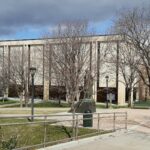
One little line in Utah’s Appropriations Adjustment House Bill may seem insignificant, but for the renovation of Weber State University’s Social Science Building, it is everything.
In the 2016 session, the Utah State Legislature decided against funding for the Social Science Building. Instead, they gave Weber permission to begin the re-design phase of the project.
The line in the Appropriations Adjustment Bill reads, “The Legislature intends that Weber State University use donated or institutional funds for planning and design of the proposed Social Science Building renovation.”
WSU President Chuck Wight said that this permission allows the university to hire an architect who will begin the designing process.
“The legislature sometimes does that as a prelude for later funding,” Wight said, “but we don’t actually have a financial commitment from the Legislature for the project yet.”
WSU Vice President Brad Mortensen explained that getting approval for the design phase “keeps the project moving forward.” The design process will take some time to complete, so theoretically, the renovation will still be on schedule if the 2017 Legislature provides funding for the project.
“The authorization is an expression of their intent to do that,” Mortensen said.
Mortensen also said that the $5 million donation that John E. Lindquist made to the Social Science Building likely had an effect on the Legislature’s decision to approve the design phase.
“The authorization emphasizes the magnitude and impact of the generous gift from John E. Lindquist,” Mortensen said. “Without his private support, we would lack the finances to undertake the design effort.”
The Social Science Building renovation will greatly benefit the programs currently housed in the building, one of which being the Walker Institute. Currently, the Walker Institute consists of four staff offices and no space for students to meet. Members of the Walker Institute have to meet in various other spaces.
“The Walker Institute needs a center where students can meet and collaborate and where we can host small seminars,” director of the Walker Institute Carol McNamara said.
A dedicated home for the Walker Institute will help them to host students, speakers and a variety of meetings in a central area.
“We’re clearly in need” McNamara said. “But we fell a little short whereas other projects had stronger pull on the Legislature this year,”
However, she described her feelings about the architectural design approval as “cautiously optimistic.”
Director of Campus Planning and Construction Mark Halverson said it was unfortunate that we didn’t receive funding this year.
Before the Legislature’s decision, the Infrastructure & General Government Appropriations Subcommittee, or IGG, ranked WSU’s Social Science Building sixth on the list of state buildings that needed funding. Utah Valley University’s proposal for a Performing Arts Building was ranked seventh on that list. However, the Legislature relegated funding to UVU’s project instead of Weber’s project.
Halverson said last year, UVU received similar permission from the Legislature to continue with the design of their new Performing Arts building, which likely influenced the Legislature’s decision to fund their project, even though Weber’s project was ranked higher by the IGG subcommittee.
“It’s a strong indication — not a promise — that we will receive funding next year,” Halverson said. “And we’ll be shovel-ready.”







